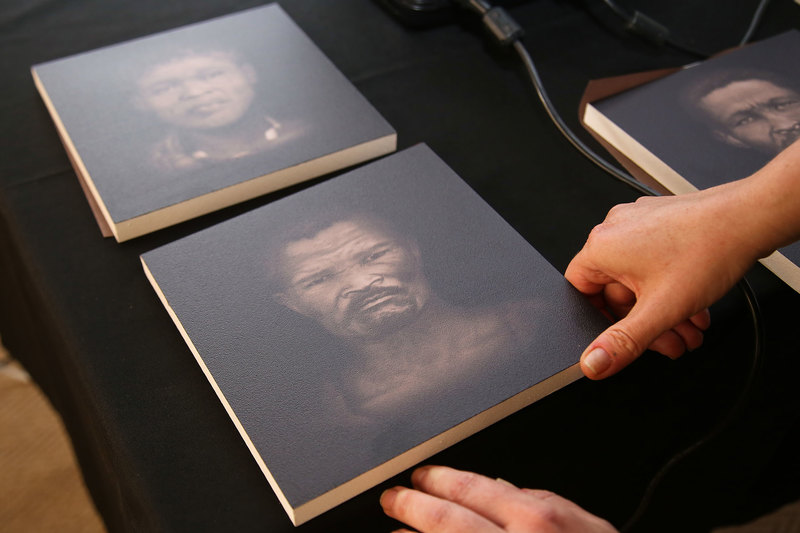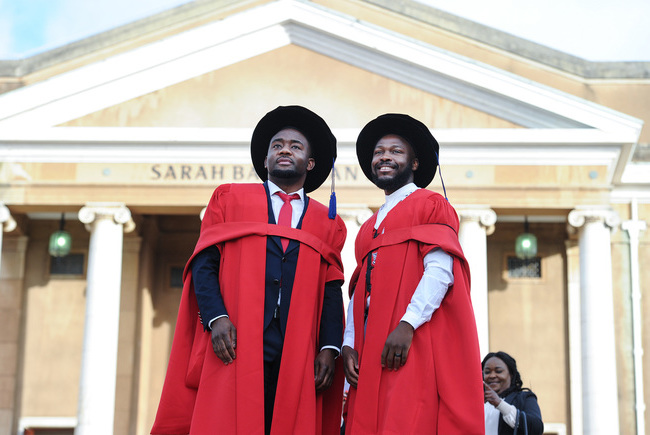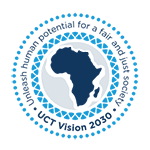New research on Sutherland Nine remains digs deeper into their lives, deaths
25 May 2023 | Story Ridovhona Mbulaheni. Voice Cwenga Koayan. Read time >10 min.
Newly published research by a multidisciplinary research team from the University of Cape Town (UCT) and other partner institutions has dug deeper into and revealed insights into the lives of the Sutherland Nine, who were donated unethically to UCT in the 1920s.
The team, led by Associate Professor Victoria Gibbon, produced a range of community-driven historical, archaeological and analytical (osteobiographic, craniofacial, ancient DNA, stable isotope) studies to document, as far as possible, the lives and deaths of the Sutherland Nine.
The research, titled “Confronting historical legacies of biological anthropology in South Africa – Restitution, redress and community-centered science: the Sutherland Nine”, was published in PLOS One on 24 May 2023.
Between 1925 and 1927, the skeletonised remains of nine San or Khoekhoe people, eight known-in-life, were removed from their graves on Kruisrivier farm, near Sutherland in the Northern Cape, and donated to the Department of Anatomy at UCT. This was done without the knowledge or permission of their families. The donor was Carel Gert Coetzee, who turned out to be a UCT medical student.
Associate Professor Gibbon, a biological anthropologist and curator of the repository at UCT, said: “Anatomy departments and museums collected human skeletal remains during the colonial era and into the first half of the 20th century for museological natural history display, curiosity, scientific and racial study. Some skeletons were acquired unethically or illegally. In particular between 1850 and 1930, human remains of San and Khoekhoe people were sought by and traded between museums and universities globally. Grappling with these legacy collections is challenging.”
UCT efforts to redress past injustices
Nearly 100 years later, the Sutherland Nine are being returned to their community in the process of restitution led by UCT. The process was begun and supported by a public participation consultant hired by UCT, Doreen Februarie, locating the two families of the individuals living in Sutherland. The restitution process prioritises the descendant families’ memories, wishes and desire to understand the situation and their ancestors.
Professor Loretta Feris, the former deputy vice-chancellor for Transformation at UCT, said: “When UCT began this process, there was no policy in South Africa for restitution or repatriation of human remains and UCT had to carve out a process in partnership with the Sutherland community. The UCT process clearly influenced the policy that came into effect in 2021.”

Gibbon said the Sutherland Nine reminded UCT of its complicity in South Africa’s reprehensible colonial past and the violence against indigenous communities. “Through restitution, an opportunity was provided for atonement, redress, learning, and healing. Examination of the remains of these individuals stands as a strong moment of agency by the descendant families who wanted to know more about their ancestors. It also revealed a very rich picture of these people’s lives,” she said.
The team wrote: “While these nine individuals were exhumed as specimens, they will be reburied as people.”
In addition to plans for reburial, the restitution process involved the families’ request to know as much information as possible about the situation and their ancestors. Thus, the multidisciplinary research team conducted the study.
A multidisciplinary collaborative approach
The team decided to approach the research results embedded within the story of the Sutherland Nine in a single, large, multi-authored publication. The entire process was governed under informed consent through a multi-layered ethical framework with and without research team members. The family members wrote in their own words what research they wanted and why, along with their restrictions on data use. “The families drove and directed the publication process and chose formal acknowledgement in lieu of authorship. The principal message of this collaborative approach is how community-driven research can benefit processes of restitution when grappling with painful legacy collections,” said Gibbon.

According to Gibbon, the Sutherland example may set a global precedent for a process of restitution and restorative justice in combination with community-driven science, contributing to redress. She added: “It may be helpful if curators and custodians of repositories of human skeletal remains elsewhere in the world attempt to redress some of the wrongs of the past.”
The research findings
The paper found that life was physically hard and violent for the Sutherland Nine, and common conditions like toothache and infections likely caused death.
In archival records, most adults were identified by first names (Cornelius, Klaas, Saartje, Jannetje, Voetje, Totje); for two, surnames were also specified: Cornelius Abraham and Klaas Stuurman. Three unnamed individuals were renamed as part of the process by the National San Council in collaboration with the descendant families. The younger boy child (four to six years of age) has been named G!ae, which translates to “springbok” – an animal symbolising the San’s pride in their culture and future prosperity. The older girl child (six to eight years of age) has been named Saa, which translates to “eland”, a sacred and spiritual animal in San culture. The other individual has been named Igue We, meaning “blessing”, to symbolise acceptance and blessing by San ancestors for his reburial.
The ninth individual was an unnamed adult said to have been buried 40 years earlier near Sutherland, although the precise burial location was unrecorded. The research has shown that he died approximately 700 years ago using radiocarbon dating. Commenting on this finding, Gibbon said there is no evidence that this individual was directly related to the other eight, but his remains came to the institution from the same donor, presumably for the same purpose as the other eight individuals.
“This window into the past reveals hardworking people with perseverance and resolve.”
The disturbed graves were located and the ZAMANI project mapped the Kruisrivier cemetery producing a 3D visual guide presented in the supplementary information linked to paper. “These results were contextualised in an archaeological and historical framework,” said Gibbon.
Despite the hardship and challenges for people living on Kruisrivier farm and others like it, Gibbon said they resisted complete assimilation into the farm owners’ way of life. “They retained some of their cultural practices, as shown by their habitual use of a resting posture with deeply flexed knees and ankles, the styles of their graves and aspects of burial practice (niche graves, inclusion of quartz pebbles), and the wearing of traditional body ornamentation. This window into the past reveals hardworking people with perseverance and resolve,” she added.
Facial reconstructions and ancient DNA
The descendant families also requested facial reconstructions and ancient DNA of the nine individuals. “These analyses were not possible in Africa, and therefore, we had international partners,” said Gibbon. Joscha Gretzinger, a PhD student under the supervision of Dr Stephan Schiffels (Max Planck Institute of Evolutionary Anthropology, Germany), joined the team to conduct the ancient DNA analyses. Among the nine, biological sex was identified, kinship and broader biological relationships within southern African populations were assessed.
Dr Schiffels said: “This was a remarkable and unusual project for us. Usually, there is a comfortable abstraction between our genetic analysis and the deceased person we describe. Here, we knew the names of the individuals and their history, which brought the events directly to our table, so to say.”
“The faces are the way into the bigger story.”
Facial reconstructions were possible for eight of the nine individuals. South African forensic artist Dr Kathryn Smith from Stellenbosch University was invited to join the team and completed the work in collaboration with Face Lab (Liverpool John Moores University, United Kinddom [UK]). Smith was supervised by Professor Caroline Wilkinson while she was a PhD candidate in the UK.
Wilkinson said: “Facial depiction involves the reconstruction of face shape through interpretation of skeletal structure and the addition of textural detail to visualise the living facial appearance of an individual. In this case, the families specifically requested facial depiction to connect to their ancestors.”
Gretzinger and Dr Smith joined several other UCT postgraduate students at the time who assisted in piecing together the stories of the Sutherland Nine, fulfilling another request from the community that the initiative should benefit student training and development.
A grant from the National Geographic Society partially supported the facial reconstruction work. Using an entirely digital workflow and validated anatomical methods, the resulting faces are an embodiment of the multidisciplinary research, presenting complex biological, ethnohistorical, and cultural information scientific findings in accessible and relatable images. Seeing their ancestors for the first time, the families said: “The faces are the way into the bigger story.”
Digging deeper into Sutherland Nine’s history
For each of the nine individuals, the researchers developed an osteobiography, assessed age-at-death, sex, stature, markers of habitual activities, and evidence of disease and injury that informed them about how they lived and died. Five of the seven adults were male, and two were female, consistent with the DNA results. Ages-at-death range from 25 to more than 60 years. All had relatively short stature (1.38–1.54 m, apart from Cornelius at 1.62 m).
The archival records dating from the 1920s stated that the donor’s great-grandfather captured both Klaas and Saartje. The records also suggested the two were husband and wife and were the parents of Saa and possibly G!ae. However, the ancient DNA evidence also showed that Klaas and Saartje were close relatives (half-siblings or double cousins), so they were unlikely husband and wife. Neither was a biological parent of either of the children, although they may have been their primary caregivers on the farm.
Despite the close genetic relationship between Klaas and Saartje, the findings of this peer-reviewed study revealed that they did not live in the same area before moving to Kruisrivier. Klaas and Igue showed substantial isotopic variation during early life, consistent with the mobile lifestyles documented for foraging communities in the dry interior of southern Africa, where groups ranged over large territories of up to 2 500 km2 annually.
Stable isotope values for Klaas showed that he spent his early childhood in an area with more summer rainfall and moved to Sutherland at around 10 years of age. This, said Gibbon, is consistent with the archival record of his ‘capture’ between Sutherland and Carnarvon.
 This work is licensed under a Creative Commons Attribution-NoDerivatives 4.0 International License.
This work is licensed under a Creative Commons Attribution-NoDerivatives 4.0 International License.
Please view the republishing articles page for more information.
Highlights from 2023
As we look back on 2023, we celebrate the stories that were most popular with readers of the UCT News website during the year.
Keep an eye on this space for highlights content that will be going live at 10:00, 12:00 and 14:00 on weekdays (excluding public holidays).

UCT law lecturer Gaopalelwe Mathiba will become the youngest person to be conferred a PhD in law in the past 11 years.
12 Jan 2024 - 6 min read Readers’ Choice 2023
Just a year after registering for his LLM at UCT, Dr Thapelo Teele’s dissertation was upgraded to a PhD.
12 Jan 2024 - 9 min read Readers’ Choice 2023
Zintle Mtsheke joins the strong contingent of successful students who have graduated during UCT’s March ceremonies.
11 Jan 2024 - 6 min read Readers’ Choice 2023
Hlamulo Khorommbi plans to lead from the front and effect positive change in students’ lives.
11 Jan 2024 - 7 min read Readers’ Choice 2023
Liziwe Futuse will graduate with her PhD in African Languages and Literature on 14 December.
10 Jan 2024 - 7 min read Readers’ Choice 2023
The City of Cape Town’s inhabitants are using too much water, contrary to warnings to implement water-saving measures.
10 Jan 2024 - 5 min read Readers’ Choice 2023
Assoc Prof Tasleem Ras is one of three recipients of UCT’s 2022 Distinguished Teacher Award.
09 Jan 2024 - 8 min read Readers’ Choice 2023
One of this year’s inspirational graduates Dr Michael Hlabathe reached for the stars to overcome adversity and obtain his PhD in astrophysics.
09 Jan 2024 - 8 min read Readers’ Choice 2023
Celebration, ululation, fashion and joy were the themes during the UCT’s autumn graduation.
04 Jan 2024 - 4 min read Readers’ Choice 2023
UCT has been named the top university in Africa in the Center for World University Rankings.
03 Jan 2024 - 2 min read Readers’ Choice 2023
UCT remains the top university on the continent, according to ShanghaiRanking’s Academic Ranking of World Universities 2023.
02 Jan 2024 - 4 min read Readers’ Choice 2023
Uyinene Mrwetyana’s brother, Esona, remembers his sister as the family’s special torch bearer.
02 Jan 2024 - 9 min read Readers’ Choice 2023
Dr Linda Mtwisha said it’s imperative to develop a national research impact assessment system where information on research outputs can be collected so that universities that don’t have adequate resources and research capacity are not disadvantaged.
29 Dec 2023 - 6 min read Readers’ Choice 2023
UCT’s Assoc Prof Deshen Moodley was recently awarded the SARChI Research Chair in Artificial Intelligence Systems.
28 Dec 2023 - 8 min read Readers’ Choice 2023
UCT proudly adds another six South African Research Chairs to this prestigious community.
27 Dec 2023 - 8 min read Readers’ Choice 2023





























